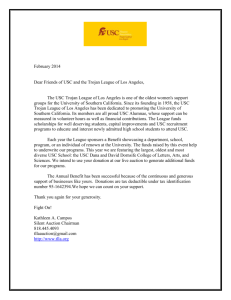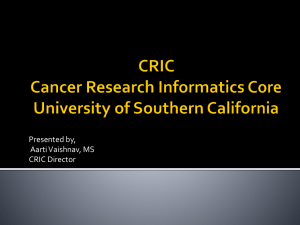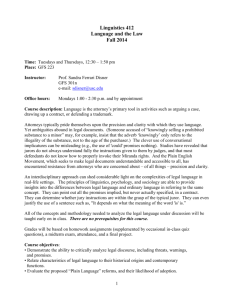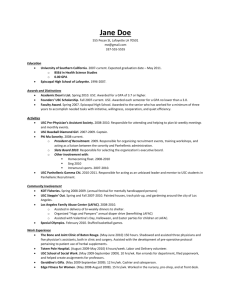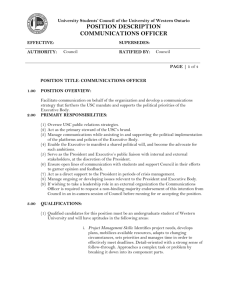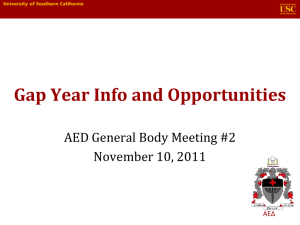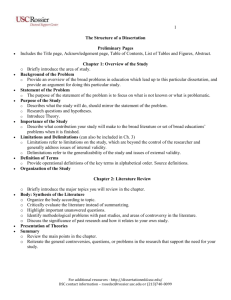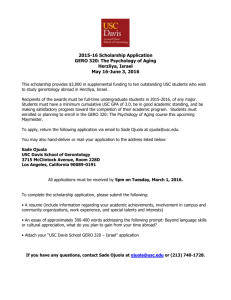Socially Optimized Learning in Virtual Environments (iSolve)
advertisement
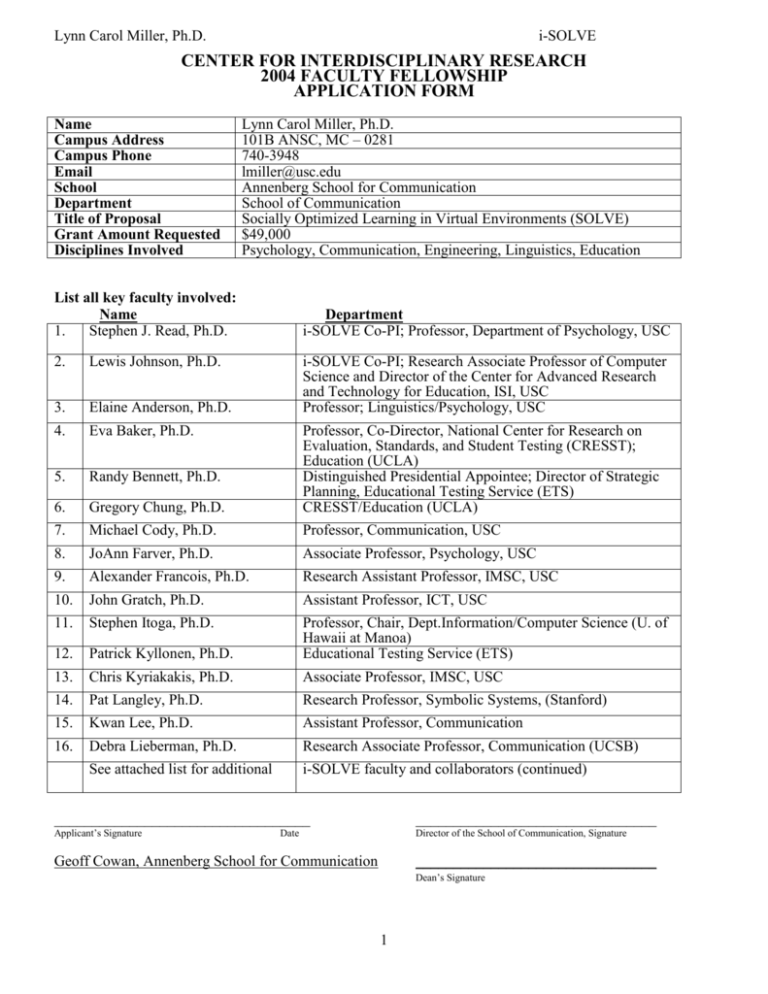
Lynn Carol Miller, Ph.D. i-SOLVE CENTER FOR INTERDISCIPLINARY RESEARCH 2004 FACULTY FELLOWSHIP APPLICATION FORM Name Campus Address Campus Phone Email School Department Title of Proposal Grant Amount Requested Disciplines Involved Lynn Carol Miller, Ph.D. 101B ANSC, MC – 0281 740-3948 lmiller@usc.edu Annenberg School for Communication School of Communication Socially Optimized Learning in Virtual Environments (SOLVE) $49,000 Psychology, Communication, Engineering, Linguistics, Education List all key faculty involved: Name 1. Stephen J. Read, Ph.D. Department i-SOLVE Co-PI; Professor, Department of Psychology, USC 2. Lewis Johnson, Ph.D. i-SOLVE Co-PI; Research Associate Professor of Computer Science and Director of the Center for Advanced Research and Technology for Education, ISI, USC Professor; Linguistics/Psychology, USC 3. Elaine Anderson, Ph.D. 4. Eva Baker, Ph.D. 5. Randy Bennett, Ph.D. 6. Gregory Chung, Ph.D. Professor, Co-Director, National Center for Research on Evaluation, Standards, and Student Testing (CRESST); Education (UCLA) Distinguished Presidential Appointee; Director of Strategic Planning, Educational Testing Service (ETS) CRESST/Education (UCLA) 7. Michael Cody, Ph.D. Professor, Communication, USC 8. JoAnn Farver, Ph.D. Associate Professor, Psychology, USC 9. Alexander Francois, Ph.D. Research Assistant Professor, IMSC, USC 10. John Gratch, Ph.D. Assistant Professor, ICT, USC 11. Stephen Itoga, Ph.D. 12. Patrick Kyllonen, Ph.D. Professor, Chair, Dept.Information/Computer Science (U. of Hawaii at Manoa) Educational Testing Service (ETS) 13. Chris Kyriakakis, Ph.D. Associate Professor, IMSC, USC 14. Pat Langley, Ph.D. Research Professor, Symbolic Systems, (Stanford) 15. Kwan Lee, Ph.D. Assistant Professor, Communication 16. Debra Lieberman, Ph.D. Research Associate Professor, Communication (UCSB) See attached list for additional i-SOLVE faculty and collaborators (continued) __________________________________ ________________________________ Applicant’s Signature Director of the School of Communication, Signature Date Geoff Cowan, Annenberg School for Communication ________________________________ Dean’s Signature 1 Lynn Carol Miller, Ph.D. i-SOLVE List all key faculty involved: Name 17. Mark Lepper, Ph.D. Department Professor and Chair, Psychology (Stanford) 18. Stacy Marsella, Ph.D. Information Sciences Institute, USC 19. Richard Mayer, Ph.D. Professor, Psychology (UCSB) 20. Margaret McLaughlin, Ph.D. Professor, Communication, USC 21. Shrikanth Narayanan, Ph.D. 22. Harry O’Neil, Ph.D. Associate Professor, Electrical Engineering, IMSC, Linguistics, USC Professor, Education, USC 23. Ute Ritterfeld, Ph.D. Research Associate Professor, Communication, USC 24. Ken Sereno, Ph.D. Associate Professor, Communication, USC 25. Cyrus Shahabi, Ph.D. Research Assistant Professor, Engineering/IMSC, USC 26. Stacy Smith, Ph.D. Associate Professor, Communication, USC 27. Lazar Stankov, Ph.D. Educational Testing Service (ETS) 28. Michael VanLent, Ph.D. Research Assistant Professor, ICT, USC 29. Terry Vendlinski, Ph.D. CRESST, Education (UCLA) 30. Hannes Vilhjalmsson, Ph.D. ISI,USC 31. Peter Vorderer, Ph.D. Professor, Communication, USC 32. Barbara White, Ph.D. Professor, Education (UC, Berkeley) 33. Wee Ling Wong, Ph.D. Research Assistant Professor, IMSC, USC 2 Lynn Carol Miller, Ph.D. i-SOLVE This past fall, a collaborative group of over 30 researchers at USC (IMSC, ICT, ISI, Annenberg School, Psychology, Linguistics, and Education), UCLA, Educational Testing Service, Stanford, UC Berkeley, UC Santa Barbara, and U of Hawaii Manoa submitted a proposal (see Appendix) entitled “Institute for Socially Optimized Learning in Virtual Environments (i-SOLVE) to NSF for a Science of Learning Center (SLC). NSF Panel reviewers felt that "if the goals of the proposals are fulfilled, the result would be a major pedagogical achievement, reaching large numbers of diverse populations of students" and "there was a strong team with good synergy between the research groups and the Annenberg [School]." Reviewers pointed to the need for additional integration and work (on our part) to allay fears that a center of this scope was premature. The PI of that SLC effort will use the Provost’s fellowship to lay the groundwork for a resubmission for the next SLC competition (May, 2005) and to facilitate the procurement of center-related interdisciplinary grants among center faculty and with corporate collaborators. She will also facilitate the development of center intellectual exchanges to advance the goals of the center and its future NSF competitiveness. Interdisciplinary Nature of the Problem and Its Importance Recently, a committee of the National Research Council identified one of four areas where research in the Science of Learning was critically needed. They argued that “there is no commonly accepted unifying theory [of motivation], nor a systematic application of what is known to educational practice… It is recommended that research be conducted to elucidate how student interests, identities, self-knowledge, self-regulation, and emotion interact with cognitive competence”[1]. An understanding is, in fact, emerging regarding the complex psychological factors that impact intrinsic motivation, engagement, and deeper learning ([2]). A growing body of work points to the role of a host of skills (e.g., communication skills, meta-cognitive skills, problem solving skills) [3] and beliefs (e.g., about the nature of ability) in enhancing motivation and deeper learning [4]. Some of these (e.g., beliefs in the malleable nature of ability) may bolster motivation in the face of social threats such as stereotype threats for girls and children of color [5]. But, how do we engage and maintain children’s attention so that they learn these skills and stay engaged in learning? Children are intrinsically motivated in games and simulations [6] and respond well to some types of one on one tutoring and social engagement in learning with others [7]. And, we know that the optimal state for engagement and learning is one in which children are challenged, but not bored – and not too overwhelmed. What if we could build tomorrow's immersive worlds where learning is embedded in a fun adventure? Where the technology was sensitive to the needs of the child, monitored that, and enhanced the responsiveness of the world to enhance learning? What if this was all happening automatically, for example, on a mission with virtual and real other children and intelligent agents in game-like immersive worlds? That’s part of the futuristic vision of i-SOLVE. 3 Lynn Carol Miller, Ph.D. i-SOLVE First, there is considerable agreement that games and simulations are likely to be part of our educational future landscape [6]. But, we need to better understand why computer games are (sometimes) motivating, so that we can draw lessons for learning system design. That is why one of the areas of i-SOLVE, called Entertainment Education (EE) will study how narrative structure, immersion, and interactivity all contribute to motivation and engagement. Another emphasis of our proposed research is on the social mechanisms for providing scaffolding and feedback, i.e., from teachers, tutors, and peers, drawing on research in how such interaction promotes learner motivation [7]. We plan to make extensive use of intelligent agents for this purpose; their “personalities,” cultural attributes, and behaviors can be carefully tailored and controlled so as to optimize scaffolding for each learner, and they fit naturally into virtual environments as guides and other non-player characters. This research will deepen our understanding of social processes in learner motivation and deep learning. Work in the Socio-Cognitive Responsiveness Group (SCR) will focus on the development of these responsive and challenging agents. Work in the Socially Engaging Agents (SEA) group will focus on creating realistic agents that children will interact with who resemble a range of potential personalities with realistic emotions from whom they may learn a variety of skills and competencies relevant to engagement and deeper learning. Finally, our vision depends critically upon learner modeling and cognitive and motivational assessment methods suitable for interactive virtual environments that measure deep learning as well as affect, motivation, and other characteristics. These will enable teachers, parents, and learners to track learner progress, and will enable the learning environments to adapt and respond appropriately in real time. They will enable teachers to make most effective use of socially engaging virtual environments to meet their curriculum objectives. These techniques will be developed in the Cognitive and Socio-Affective Assessment Group (CSAA). A major overarching goal of i-SOLVE is to develop a systematic, testable theory of motivation and learning that builds upon this research, and that affords a technology-enabled real-time test-bed for testing these system links and parameters and their integration, as depicted in Figure 1 (below). The implementation of this vision requires extensive collaborations across a range of disciplines (Communication, Education, Linguistics, Psychology, and Computer Science and Engineering). These connections (and collaborations) have been established (many are of long standing). Nature of the Interdisciplinary Research The Learning Federation Roadmap[6], based on extensive reviews and interviews with researchers, argues for the critical need to understand the basic science that affords the technology for enhancing learning in effective tutoring systems, and in virtual and gaming environments. We concur and have devised a working conceptual framework 4 Lynn Carol Miller, Ph.D. i-SOLVE (Figure 1) to guide our research in advancing these technologies (Green Research Areas) and the science of learning. Four major factors, gleaned from a considerable body of research, appear to play important roles in children’s declining intrinsic motivation with years in school [2]. For each we consider what technology could do to help. First, there is a decline in the control and autonomy granted to the child generally, and especially at the time that their desire for control and autonomy increases in the transition period into junior high. Technology could scaffold students in subtle ways through environmental manipulation so that they feel more control and access, which should enhance their motivation, engagement, and learning. Second, there is an increasing tendency to present material in a decontextualized, abstract fashion, separated from the uses to which it is put in the “real” world. Virtual worlds, including games, virtual and real social others, and inquiry tools can contextualize learning and make it clear how learning affords the achievement of a larger goal important to the child. Third, there is an increasing tendency for teachers and the school system today to focus on performance goals (e.g., high grades, high test scores) and to use competitive activities and normative comparisons (“which child is doing best“). Stressing the latter goals, rather than mastering the material, leads to large decreases in students’ interest in math [8]. Virtual worlds can manipulate, test, and tune alternative strategies for enhancing student interest and motivation. (4) There may be decreases in the level of challenge of the tasks being learned in school. Moreover, it may be that because of changes in the organization of the system and the increasing depersonalization, it is increasingly difficult for teachers to provide individualized instruction and attention, and tune the level of challenge. Technology could provide tailored, real-time, responsive feedback that challenges students and do so in subtle ways, tuned to the child. Technology-assisted virtual worlds, in short, could provide solutions to each of these problems to aid teachers, parents, and other educators in keeping our children motivated, engaged, and learning. The center proposes a series of projects over a ten year period to enhance student intrinsic motivation and engagement in learning using technological interfaces in four work areas (in green) suggested in Figure 1. These interfaces, would: (1) monitor children’s “real-time” cognitive representations and generate assessments for use by teachers, learners, parents, as well as by other learning technologies, (2) measure children’s changing motivational and emotional state and integrate cognitive and conative models to most effectively enhance individual motivation and learning outcomes, (3) afford engaging personified social agents that support modeling, social engagement, collaborative learning and skill development, and (4) afford immersive interactive virtual game environments supporting collaborative interactions with real and virtual others in which learning is and remains engaging, monitored, and supported via responsive technologies. Research in each of these areas will greatly expand the science of learning 5 Lynn Carol Miller, Ph.D. i-SOLVE across diverse interdisciplinary boundaries. For example, work on the entertainment experience is focused on systematically manipulating a variety of factors (interactivity, narrativity, presence, game logic, etc.) and studying how these factors impact attention to and engagement in the content domain that then impacts deeper learning. Expertise in game logic and design, engineering, communication and media studies, and psychology (as well as industry experience) will be brought to bear in these projects. Figure 1. A Conceptual Framework for Socially Optimized Learning in Virtual Environments This fusion of engineering and social science interdisciplinary efforts to accomplish specific sub-goals of the center can be found in every major division of the center grant. In addition, a major goal of i-SOLVE is to develop a systematic, testable theory of motivation and learning that builds upon this research, and that affords a technology-enabled real-time test-bed for testing these system links and parameters, as depicted in Figure 1. This will also provide the elements for integrating these components into increasingly responsive social worlds for learning. Proposed Work Plan and Products To advance i-SOLVE and its chances of success in future NSF competitions (the major product is the NSF 6 Lynn Carol Miller, Ph.D. i-SOLVE resubmission in 2005), the PI will: a) engage center faculty at least monthly in fostering intellectual exchanges for reviewing, rethinking, and rewriting the proposal, b) discuss critical research that could be undertaken now to strengthen i-SOLVE’s chances in the next competition, c) assist center faculty and collaborators in developing proposals for and securing funds for that research that would advance i-SOLVE, d) seek input from i-SOLVE’s advisory board regarding the proposal, e) develop an effective communication and dissemination network for intellectual exchange among center members (and for better positioning the center in the next competition), f) establish a College-Organized Research Unit (ORU) for i-SOLVE, g) engage in discussions with relevant Deans and faculty to enhance faculty-student collaborations and programs to advance i-SOLVE’s research goals. References (complete 308 references in Submitted NSF i-SOLVE grant in Appendix) (1)NationalResearchCouncil, How people learn: Brain, mind, experience, and school. 1999, Committee on Developments in the Science of Learning. J. D. Bransford, A. L. Brown, & R. R. Cocking, (Eds.). Commission on Behavioral and Social Sciences and Education.: National Academy Press. (2)Lepper, M.R. and Henderlong, J., Turning "play" into "work" and "work" into "play": 25 years of research on intrinsic versus extrinsic motivation., in Intrinsic and extrinsic motivation: The search for optimal motivation and performance, J.M. Harackiewicz, Editor. 2000, Academic Press: San Diego. p. 257-307. (3) White, B., & Frederiksen, J., Inquiry, modeling, and metacognition: Making science accessible to all students. Cognition and Instruction, 1998. 16(1): p. 3-117. (4) Dweck, C.S., Self-theories and goals: their role in motivation, personalty, and development. 1999, Philadelphia, PA: Taylor & Francis/Psychology Press. (5) Aronson, J., Fried, C. B., & Good, C., Reducing the effects of stereotype threat on African American college students by shaping theories of intelligence. Journal of Experimental Social Psychology, 2002. 38: p. 113-125. (6) Federation, L., Learning Federation's Learning Science and Technology R&D Roadmap. 2003. (7) Lepper, M.R., Woolverton, M., Mumme, D. L., & Gurtner, J., Motivational techniques of expert human tutors. In Computers as cognitive tools, S.P.L.S.J. Derry, Editor. 1993, Erlbaum: Hillsdale, NJ. (8) Anderman, E., Eccles, J., Yoon, K., Roeser, R., Wigfield, A., & Blumenfield, P, Learning to value mathematics and reading: Relations to mastery and performance-oriented instructional practices. Contemporary Educational Psychology, 2001. 26: p. 76-95. Interdisciplinary Innovation fund Grant 7

